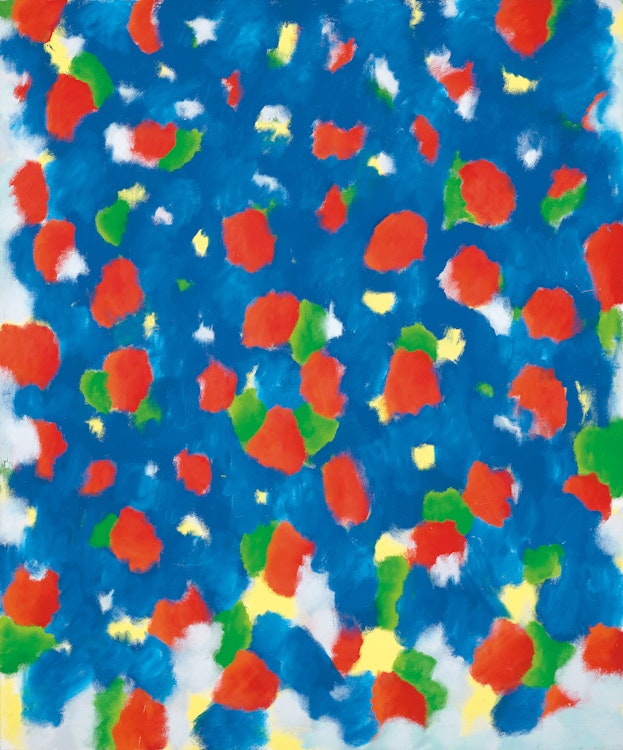Night Blue Red - B by Gershon Iskowitz

Gershon Iskowitz
Night Blue Red - B
oil on canvas
signed, titled and dated 1981 on the reverse
54 x 45 ins ( 137.2 x 114.3 cms )
Auction Estimate: $25,000.00 - $35,000.00
Price Realized $47,200.00
Sale date: September 24th 2020
W.R. Mitchell & Associates Fine Art Limited, Calgary
Sinai Health Foundation, Toronto
David Burnett, “Iskowitz”, Toronto, 1982, page 72
Adele Freedman, “Gershon Iskowitz: Painter of Light”, Toronto/Vancouver, 1982, pages 4, 6, 132 and 148
Roald Nasgaard, “Abstract Painting in Canada”, Toronto/Vancouver, 2007, page 244
The artist’s quintessential breakthrough was the 1967 helicopter ride over Churchill, Manitoba afforded by a Canada Council grant awarded to Iskowitz. This experience formed the entire body of work Iskowitz would produce as the shift in perspective fundamentally affected Iskowitz’s approach to painting: “The perspective became one of looking down at nature - or it’s metaphorical shorthand, the swirling dots - through endless blankets of grey cloud.” Rather than considering the landscape for its finite representational qualities, the artist, having shifted viewing perspectives, found inspiration in the abstracted coloured forms apparent from the aerial perspective.
Having devoted his practice throughout the 1960s and 1970s to the exploration of light in this new altered perspective, Iskowitz encountered a new challenge in 1981: “He wished to convey ‘a feeling of the night, a feeling of mystery with lots of depth, unity and composition.’...Iskowitz left the age of light behind and entered the era of electricity.” Roald Nasgaard writes that “In the 1980s, Iskowitz upped the ante by electrifying his colours, intensifying their contrasts and hardening the contours of his form.” “Night Blue Red – B” is an excellent example of this artistic transition for the artist.
Hovering in a unique space between abstraction and landscape, “Night Blue Red – B” typifies the artist’s process distilling the “moment when the vision of the landscape, the imagination, and the memory of experiences are united in the intuitive expression of the painting.”
This artwork is being sold to benefit Sinai Health Foundation. Sinai Health Foundation, with its partners Arthritis Research Foundation and Bridgepoint Foundation, raises and stewards funds to support Sinai Health. Sinai Health is Canada’s leading integrated health system and comprises Bridgepoint Active Healthcare; Circle of Care; Lunenfeld-Tanenbaum Research Institute; and Mount Sinai Hospital, Joseph & Wolf Lebovic Health Complex. The generous support of their community fuels everything they do, from seamless care to scientific discovery.
Share this item with your friends
Gershon Iskowitz
(1919 - 1988) RCA
Born in Kielce, Poland, in 1919, Gershon Iskowitz immigrated to Canada in 1948 after surviving two Nazi concentration camps (Auschwitz labour camp in Poland and later Buchenwald, near Weimar, Germany). As a child, Iskowitz had an aptitude for art. He created advertisements for his local movie theatre in a section of his family’s living room that his father portioned off to create a small studio.
Following the Nazi occupation of Poland, Iskowitz was placed in the Kielce Ghetto. Once liquidated, Iskowitz was imprisoned in concentration camps in Poland and Germany. While he continued to make drawings during this period only two survive: Condemned (1944-46) and Buchenwald (1944-45). Upon liberation, he lived in the Feldafing Displaced Persons Camp and audited courses at the Academy of Fine Arts in Munich.
Upon receiving a temporary travel document from the Military Government for Germany, issued to stateless people, Iskowitz traveled to Canada via the United States in 1948 where his extended family greeted him at Union Station in Toronto. Until 1954, Iskowitz’s paintings focused on memories from his imprisonment. In the same year, he was included in the Canadian Society of Graphic Art exhibition at the Art Gallery of Ontario (AGO) alongside Painters Eleven artist Oscar Cahén.
By the 1960s Iskowitz’s style transformed from gestural to abstract. He became interested in exploring the Canadian landscape rather than his wartime memories during this period. After exhibiting at Gallery Moos in October 1964, for the first time, Iskowitz formed a close relationship with the owner, Walter Moos. Moos managed Iskowitz’s career and finances from this point forward. After receiving a Canada Council grant in 1967 he flew to Churchill, Manitoba. Entranced by aerial views he saw while in flight, Iskowitz began incorporating this perspective into his art.
Iskowitz was selected to represent Canada alongside Walter Redinger at the Venice Biennale in 1972 where he displayed four of these areal diptychs. In 1982, the AGO put on a retrospective exhibition of Iskowitz’s life work. After the retrospective exhibition had concluded, Iskowitz set up a foundation that would provide financial support to artists through an annual monetary prize, with assistance from Moos.
Literature Source: Ihor Holubizky, Gershon Iskowitz: Life and Work. Toronto: Art Canada Institute, 2018 (https://aci-iac.ca/art-books/gershon-iskowitz)
We extend our thanks to Danie Klein, York University graduate student in art history, for writing and contributing this artist biography.

